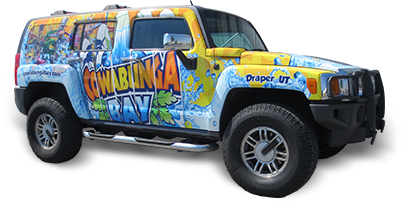More and more business owners are finding that vehicle wraps are extremely cost-effective in terms of advertising dollars. It is estimated that a vehicle wrap can generate 30,000-60,000 impressions a day. Since most vehicle wraps last between three to five years, cost per impression won’t even be enough to talk about. We’re talking a tiny fraction of a penny! Whether you’re looking for an effective advertising medium or just want to make your car look cool, discover how the low cost of vinyl car wraps can be a sure way to turn heads any time you’re driving around town!

Frequently Asked Questions:
What is a vehicle wrap?
A wrap is a large vinyl graphic or decal that is applied over the original paint of the vehicle. This form of vehicle advertising is popular in Salt Lake City and throughout Utah.
What's the process involved in a wrapping a vehicle?
Vehicle wraps are produced in three phases. The first is the design phase, which includes measuring and photographing the vehicle, designing and producing digital graphics, and creating printable files. The second is the production phase where the graphics are printed and laminated. The third is installation where the printed vinyl is applied to the vehicle. In some cases there may be a fourth phase, which is the removal of the graphics if requested.
What's the difference between a partial and a full wrap?
Typically, a full wrap covers all the painted surfaces of the vehicle (excluding the roof on larger vehicles where it is not visible from the ground). Anything less than a full wrap is normally called a “partial wrap.” A half wrap normally includes the entire rear, halfway up the sides of vehicle, and a hood logo. A three-quarter wrap normally includes the entire rear, the sides of the vehicle up to the front of the doors, and a hood logo. Each of these variations will have a different car wrapping vinyl cost.
How long will the wrap stay on my vehicle?
Under normal conditions, a wrap is expected to last between three to five years. The life of your wrap depends on a number of factors, including weather conditions, prolonged exposure to sunlight, and how you care for it.
Will a vehicle wrap damage my paint?
In most cases vehicle wraps will not damage factory paint jobs. Oftentimes color change vinyl car wraps are used instead of a full body paint job. Paint in poor condition, however, may peel when vinyl is removed.
Do I need to wash my vehicle before installation?
Yes. All vehicles must be free of dust, mud, wax, oil, Armor-All and other agents that may prevent the vinyl from adhering to the paint surface.
How long will it take to wrap my vehicle?
Production time of vehicle wraps will vary widely from project to project. Design can take between several days to several weeks. Print and installation generally takes two to three days. We will need your vehicle in the shop for installation between one to two days.
If my vinyl vehicle wrap graphics are damaged, can they be fixed?
Yes. You can normally have the damaged pieces or panels of your vehicle wrap replaced after your vehicle is repaired. You normally do not need to redo the entire wrap if the damage is limited to certain areas of the vehicle.
Can you wrap a leased vehicle?
You must always obtain permission to wrap a leased or rented vehicle. However, in general, most leased or rented vehicles have factory paint jobs with excellent paint quality; so if you are looking to change the color of the vehicle, car wraps are typically a good solution because vinyl applied over factory paint is best. The vinyl, in this case, can be removed easier without damage or “paint peel.” Leased vehicles are often wrapped throughout the country without incident or damage.
How do I care for my wrap?
Hand washing is best. Try to avoid high pressure washes and be careful never to use an ice scraper on window graphics. There are specially designed products to clean and polish vinyl graphics. We will be happy to tell you about them.
How much does a vehicle wrap cost?
Vinyl car wrapping costs varies from vehicle to vehicle. We do all of our pricing by quote to make sure you get the best price for your project. When we give you a quote on a project, we consider four important things: design time, materials (including vinyl and lamination), print, and installation. The time required by our designers to achieve the design you want will have an influence on the cost. Whether it be an advertising vehicle wrap or a classic color change wrap, our designers will help you get a unique design that you’ll love. The size of the vehicle to be wrapped and the type of vehicle also play a part in cost. In general, vehicles with compound curves and indentations, such as VW Beetle or PT Cruiser, are more difficult and the full vinyl car wrap cost will be more than a vehicle with more angular contours. Wrapping larger vehicles will require a higher printing cost, so partial wraps are a great way to minimize cost as opposed to a full wrap. Cast (high performance) vinyl is more expensive than Calendared (intermediate) vinyl, but lasts longer. Be sure to ask for details about our car wrap costs.
How can I justify the cost of a vehicle wrap?
If you are using a vehicle wrap as signage, there is no more cost-effective advertising method available. It has been proven that the cost per impression (CPI) of vehicle wraps is far less than other forms of advertising such as billboards, television, radio and yellow pages. If you are using your vehicle wrap to improve the appearance of your vehicle, a vinyl auto wrap that is digitally printed simply can not be duplicated by more traditional methods like paint or airbrushing.
Can you easily remove vinyl graphics used for wraps?
Yes, in most cases. The vinyl used for vehicle wraps is designed to be removed with no residue. If the vehicle’s paint is old or peeling, it might peel up with the vinyl when it is removed.
Can I see through vinyl on the windows?
You can see through window graphics that are printed on perforated window material. This material is perforated with very small holes that allow you to see out. From inside the vehicle, visibility is similar. For safety reasons the front windshield and the front driver and passenger windows should not have vinyl graphics. Normally the rear window and the passenger and driver side rear windows can be covered.
What is the best base color for a vehicle that is going to be wrapped?
The vinyl vehicle wrap material is completely opaque, so paint is not visible through the material. However, the vehicle’s base color will be visible in the cracks and other unwrapped areas, such as for example in the grill or under the door handles. For this reason, it is best to use either a black or a white vehicle.
Which surfaces of my vehicle can be wrapped?
The adhesive on our vehicle wrap material is designed to stick to the slick painted surfaces of vehicles without damaging factory paint when removed. The adhesive doesn’t stick as well to porous surfaces, such as plastics or rubber trims. This should be taken into consideration when laying out your graphics.
What is the difference between a vehicle wrap and vinyl vehicle lettering?
Vehicle wraps and vehicle lettering are both done using the same top quality vinyl. The largest differences have to do with coverage area and design. Typically a full vehicle wrap will include a custom design while vehicle lettering will include a vinyl logo and some text. Additionally, full car wraps will cover the whole vehicle surface while vehicle lettering and decals cover a much smaller area. Vehicle lettering is a good option when you have a limited budget or when the purpose of the wrap is simply vehicle identification. A wrap specialist will help guide you to the option that best suits your needs.
